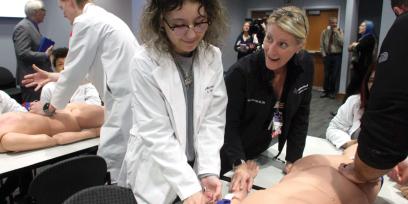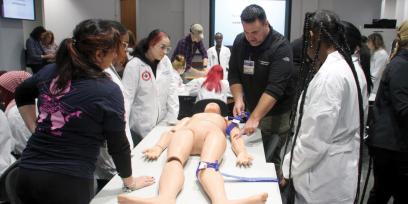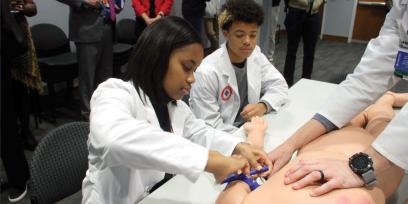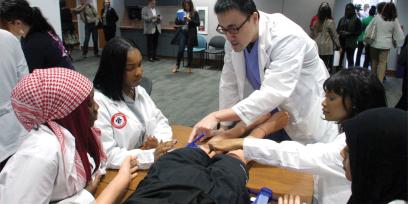On a busy Wednesday morning, several high school teachers are expertly directing a lively group of students gathered around their lockers to the correct places to begin the school day. But even though the hall has lockers and classrooms and school posters, this is not a school building; it is the MetroHealth Main Campus Medical Center, and the high school students are wearing white hospital coats and genuine hospital ID badges.
This is the Cleveland Metropolitan School District’s Lincoln-West School of Science and Health (LWSH). Its partnership with Cleveland’s MetroHealth main hospital is a unique model for experiential learning and career preparation.
In this high school housed in a hospital, students study a biomedical curriculum with a STEM (science, technology, engineering, and mathematics) focus, in addition to more traditional high school courses. They learn firsthand about the variety of careers available in a hospital system and work one-on-one with a mentor who is a healthcare professional. They receive training in advanced healthcare programs such as Stop the Bleed, the American College of Surgeons program that teaches how to stop bleeding in a severely injured person, and Code Red, which is training for an emergency that includes CPR, AED (automated external defibrillator), and first aid certification. Students have access to internships and networking opportunities in the hospital system, which can lead to jobs in the system. Juniors and seniors also have an opportunity to earn state tested nurse aide (STNA) credentialing in an accelerated three-week program in the spring.
“This school—a high school embedded in a hospital—is the only program of its kind in the country,” explained Shari Obrenski, president of the Cleveland Teachers Union. “The former CEO of Cleveland’s MetroHealth hospital system, Dr. Akram Boutros, had a vision about what a hospital system should be to a community. And it’s far more than just taking care of the physical health of the people. He really was taking a look at the determinants of health and asking, ‘How can our hospital impact those determinants of health?’ And one of the determinants was around education and how the hospital system could be part of that.”
Preparing for Careers in Healthcare
In grades 9–10, students attend regular classes in the Lincoln-West school building, and they also attend regular MetroHealth experiences—presentations, trainings, and activities—at both the school and hospital locations. In December, for example, 10th-graders attended a presentation on nutritional disparities and their relationship to community health. It included information about nutritional resources available in the community, a discussion with a dietitian, a cooking demonstration, and an explanation of the healthy plate model.
In grades 11–12, students take all their classes at the hospital. They have regular high school classes on Monday, Tuesday, Thursday, and Friday. The LWSH wing at the hospital campus has classrooms for core and elective subjects such as English, math, history, psychology, chemistry, Spanish, and various biomedical sciences, with teachers assigned full-time to the site.
Juniors are assigned to mentors based on their interests and meet at least once a month. They also attend lectures and presentations by different healthcare professionals, learn about a wide array of career possibilities in the hospital system, and participate in a variety of healthcare experiences. Seniors are engaged in internships on Wednesday mornings. On a drab Wednesday in January, MetroHealth secondary education specialist Salethia McPherson energetically delivered morning announcements to the quiet group of seniors, including opportunities for afterschool activities that could be included on their college applications and important details about applying for the spring STNA certification program. Her comments incorporated an encouraging “pep talk” and some specific instructions before sending the seniors to meet their internship supervisors throughout the hospital.
On Wednesday afternoons, seniors participate in a capstone study experience. This is a regular course in every senior’s weekly schedule, in which they journal about their internship experiences from the morning, recording their observations and assessments. As a culminating activity, students use this information to study problems or situations they observed at the hospital and devise possible solutions. One recent capstone study was about improving the emergency department patient experience. Students discovered that the ED was short-staffed on weekends, one of the busiest times. The students proposed possible solutions, such as compensation incentives for those who work on weekends and expanding and enhancing the ED area to better accommodate patients.
For its healthcare-related courses, the school uses a curriculum developed by Project Lead the Way that combines the study of biology with principles of biomedicine. Students engage in case studies with a series of labs, dissections, and other procedures to determine diseases. They learn how to measure blood pressure and what the normal levels for blood pressure and cholesterol are. They study human anatomy and physiology along with medical interventions and biomedical innovations.
Students also get training from emergency department doctors, ultrasound technicians, and other healthcare professionals. They get hands-on experiences in various departments in the hospital system and see firsthand not only different medical careers, but jobs in other areas such as human resources, finance, business, nutrition and culinary services, and information technology. And side by side with teachers, the hospital’s medical professionals provide in-depth explorations that go beyond books and classrooms. For example, when teachers were instructing on the topic of health disparities, including environmental disparities in the community, MetroHealth provided information about lead poisoning, with real-life examples. In another instance, students were engaged in a dissection of cow eyes, and a physician from the hospital’s ophthalmology department provided a deeper experience for students.
“We are building a school-to-workforce pipeline,” said LWSH’s principal, Juliet King. “We are getting students engaged in STEM, and this model is changing the game in so many ways. We hope this inspires others to see education in a different way.”
The Lincoln-West School of Science and Health opened in the fall of 2016, and the first senior class graduated in 2019. Although LWSH is highly regarded and students are thriving, there is one major challenge: space. In grades 11–12, due to space limitations at the hospital, only 50 students can be accepted in each grade. “We are very hopeful now, with the opening of the new MetroHealth Glick Center and additional available space, that more students can continue in the program in grades 11–12,” said Obrenski. “In 9th and 10th grades, we have about 100 students in each grade. But in 11th and 12th grades, the hospital can currently only take 100 students total, 50 in each grade, so the program is losing up to 100 students in grades 11–12. We need to fix that and make sure that we can accommodate all of them—not half of them—in this valuable program.” The need to accommodate more students is especially pressing because of the success LWSH is having. Its graduation rate of 85 percent1 is 10 points higher than the district’s graduation rate.2
One of those graduates is Khandah Abdullah, the 2023 valedictorian; she now attends Cleveland State University majoring in biology. “I was interested in studying medicine but had limited knowledge about the high school, even though my brother graduated from Lincoln-West two years earlier,” she said. “I didn’t realize how unique the program was and what great opportunities it provided.”
She was planning a career in nursing when she entered the school in the fall of 2019. In her junior year, her mentor was a nurse. “I learned a lot from that experience and from my senior-year internship about the reality of a nurse’s schedule, duties, and expectations.”
Abdullah participated in the white coat ceremony in fall of 2022 and obtained her STNA credentials in the school’s accelerated three-week program in the spring. With her experience and training at MetroHealth, she is now qualified to work as a patient care nursing assistant (PCNA).
“I wouldn’t be able to work at this level, a PCNA, without the experiences I had through the Lincoln-West/MetroHealth program,” she said. “Other college students I meet are surprised because they are just starting to learn those skills now. I learned them in high school.”
The exposure to real career experiences was valuable in other ways, too. She learned what it takes to run a big hospital. “There’s a lot more than doctors and nurses. There are so many specialties and other career opportunities, and they aren’t all in direct patient care. We learned about many different jobs in a hospital system. This program helped me find my passion.”
Creating Opportunities
MetroHealth is a unique partner in that it is a community hospital, and addressing the social determinants of health—such as affordable quality housing and education, nutritious food, public transportation, and well-paying jobs—is one of its key goals. Cleveland has some of the best healthcare institutions in the world, but its population also has some of the worst health outcomes. Across two communities just two miles apart, there is a 23-year difference in residents’ average life expectancy.3 This is in large part because the social determinants of health have a huge impact on health and well-being—often far greater than healthcare4—and Cleveland is the second-poorest large city in the United States.5
Although the LWSH program has open enrollment for students throughout the district, most of its students live in the MetroHealth hospital area. The hospital is located just west of Cleveland’s downtown, in a racially mixed area with a significant Hispanic and Latinx population. While English is the most prevalent language, Spanish is second, with 21 percent of residents speaking it at home. The median annual household income in the area is $32,000.6
“The partnership between Lincoln-West and MetroHealth began with a very different vision than many specialty schools that accept only certain qualified students,” explained Obrenski. In this school, the original vision was to enroll kids from the nearby community, if they chose to attend, and genuinely involve them in all of the work of the hospital, exposing them to all of the different jobs associated with the hospital, teaching them about health factors, and improving health and economic outcomes for them and their families. The vision has only grown from there.
Students are finding many personal connections to their learning. For example, when AFT President Randi Weingarten visited LWSH, students were engaged in a Stop the Bleed training. They were told that there are many different types of traumatic bleeding that they might encounter and were asked what type they wanted to focus on. Every student chose gunshot wounds because that’s what they too often deal with in their community. They have all been impacted by gun violence in some way, and now they have the knowledge and skill to increase a victim’s odds of survival.
Another example is an LWSH student who learned to identify stroke symptoms. When he recognized that his grandmother was having a stroke, he called an ambulance immediately. His grandmother received timely treatment for the stroke in the ambulance on the way to the hospital, and it greatly improved her outcome. “There are lots of stories like that,” added Obrenski. “Students are working in the hospital, both as interns and in the summer, and graduates of the school are now employed in the hospital. Students and their families and communities are benefiting from their healthcare knowledge and employment opportunities.”
The community-focused aspect of MetroHealth is central to the partnership’s success. People of color face the effects of racism every day, and societal and economic inequities are apparent in their poorer health outcomes.7 Adding to the problem, mistrust of the medical field is more common among Black and Latinx people than white people, often as a result of discrimination.8 By enrolling and then employing students from the community, the partnership is helping to address some of the inequities and rebuild trust.
“We are trying to create pipelines out of poverty,” said McPherson. “It starts with students from the community having meaningful, hands-on experiences in the healthcare field. That leads to building valuable skills that can be applied to a job or career that can economically sustain a household and that creates better, healthier communities. That’s the golden ticket, that’s the pipeline, and it starts with kids from within the community.”
Pamela Hummer is the editor of Critique, the Cleveland Teachers Union newspaper, and the monthly newsletter of the Northeast Ohio AFT retirees’ chapter. A retired early childhood teacher and former union representative, she volunteers weekly in several Cleveland preschool and kindergarten classrooms.
Endnotes
1. Ohio School Report Cards, “Lincoln West School of Science & Health: School at a Glance,” Ohio Department of Education and Workforce, reportcard.education.ohio.gov/school/016429.
2. Ohio School Report Cards, “Cleveland Municipal: District at a Glance,” Ohio Department of Education and Workforce, reportcard.education.ohio.gov/district/043786.
3. K. Warren and J. Ahern, “The Poorer Your Neighborhood, the Shorter Your Life,” Center for Community Solutions, December 4, 2019, communitysolutions.com/research/life-expectancy-race-ohio.
4. J. Phillips, “Achieving Health Equity: The Invaluable Role of Nurses,” AFT Health Care 4, no. 2 (Fall 2023): 30–38, aft.org/hc/fall2023/phillips.
5. E. Campbell, “Cleveland Is Again the Second Poorest City, but There Is Some Good News on Race and Gender,” Center for Community Solutions, September 18, 2023.
6. 25Connects, “Community Data,” 25connects.com/community-data.
7. Centers for Disease Control and Prevention, “Racism and Health,” US Department of Health and Human Services, September 18, 2023, cdc.gov/minorityhealth/racism-disparities/index.html.
8. J. Lewsley and R. Slater, “What Are the Effects of Racism on Health and Mental Health?,” Medical News Today, May 31, 2023, medicalnewstoday.com/articles/effects-of-racism.
[Photos: Suzannah Hoover]




